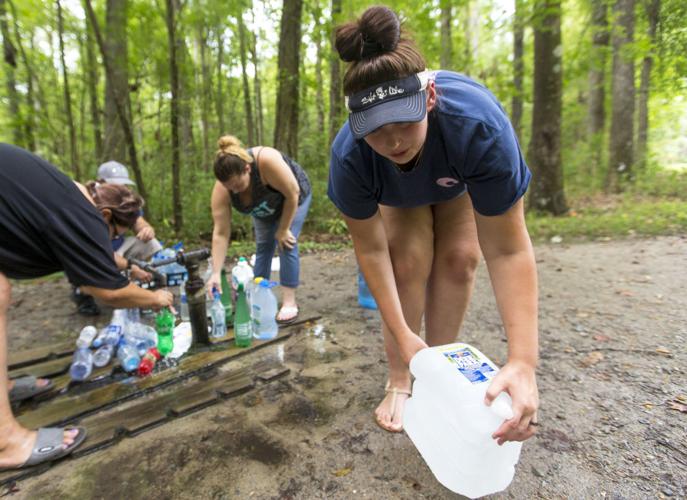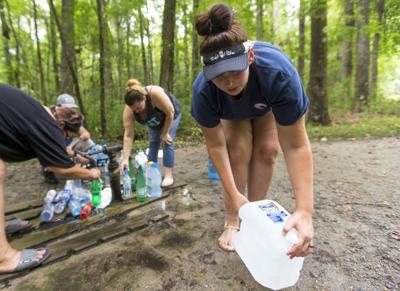DENMARK — More than a year has passed since the controversial chemical in this city's drinking water was first discovered.
Nationwide media coverage followed. So did two lawsuits. And hundreds lined up for bottled water, fearing what flowed from their taps.
While Denmark has now turned into an example of failing infrastructure and injustice on the presidential campaign trail, views about the safety of its water have created lasting fracture points in this small city of 3,000 people about 20 miles southwest of Orangeburg.
They show up on the Facebook pages of local groups and at community meetings, where council members and public commenters debate whether the water — and city officials — can be trusted.
Many of Denmark's leaders stand behind the water's quality, citing surveys from state and federal health officials that report it is safe to use. The concerns over the water is only coming from a small group of people, they say.
“The water quality here is not in question,” Mayor Gerald Wright said at a recent council meeting.
But for others, the words from city officials are not enough. The S.C. Department of Health and Environmental Control says the water is safe, too, but it was that agency that allowed the chemical HaloSan to be used in the past, they say.
"There is no test they can conduct that we would believe," Deanna Miller-Berry, founder of the Denmark Citizens for Safe Water group, said.
On average, Berry said, her group distributes cases of bottled water to over 1,000 people each month. Residents also go to a nearby springs, just outside of Denmark, to collect water.
In the meantime, what's left amid the finger-pointing is a lack of trust — in the motivation of the people bringing accusations and in the leaders and agencies tasked with making sure the water is safe.

People shop at the Foodliner Denmark grocery store in Denmark. Andrew J. Whitaker/Staff
HaloSan
Denmark's water system, like other rural communities, has had issues in the past, at times receiving "unsatisfactory" and "needs improvement" ratings from state regulators for its water quality and protection of users from contamination.
In 2008, state officials noted that they had received "complaints regarding discolored water as well as objectionable tastes and odors." The system also had issued several boil-water advisories due to line breaks and loss of pressure at a well, according to DHEC.
That same year, DHEC approved the use of the chemical HaloSan to treat iron bacteria in a city well. A national standards institute said it was acceptable for use in drinking water. But the Environmental Protection Agency did not approve its use.
An EPA assessment from 2007 suggested it could cause eye and skin irritation, symptoms that residents in Denmark have described.
Residents of Denmark, S.C. tell stories of brown-tinted water, odors of sulfur or sewage, dulled clothes coming out of washing machines and sediment pouring out of faucets into bathtubs.
While the use of the chemical was listed in agency documents, its use was not widely known until Marc Edwards, an environmental and water resources engineering professor at Virginia Tech, spotted it last year. Clemson University, which regulates pesticide use in South Carolina, ordered Denmark to stop using HaloSan. DHEC then gave Denmark officials two options: either find a replacement chemical or remove the well from use.
City officials took the well offline in August 2018 and it remains unused. The city's three other wells were never treated with HaloSan, DHEC said.
But, for some, the damage caused by the decision was already done.
“They should have never used it," Bakari Sellers, an attorney and former state legislator who grew up in Denmark, said.
He is one of two attorneys representing residents in class-action lawsuits against the city. Both mention the city's use of HaloSan.
The disclosure sparked national attention, including coverage in a investigative documentary on CNN, where Sellers works as a political commentator.
'Water complaints'
Recent DHEC surveys say the water has improved. One evaluation from April gave that city a "satisfactory" rating for its water quality and contamination protection.
But the agency added in a summary report on the survey "Considering the history of discolored water complaints in Denmark, this item will be closely evaluated during each subsequent Sanitary Survey."
DHEC also noted issues with the city's water storage and system flushing during that April review. It issued a consent order against the city last month.
Wright, the mayor, said that the city continues to work to improve the water system, which serves roughly 5,600 people, including residents, students at two local colleges, and commercial and industrial properties.
“I appreciate concerns about water," he said during a recent city council meeting. "We haven’t pretended that there are not things to be done. But if we had to grade ourselves, we would get high grades for our efforts and for the results.”
Wright, 75, said he has spent all but four years of his life in the city, and it would be "the height of foolishness if I didn’t have a concern about the quality of water that I use."
But assurances from Wright, DHEC and the EPA about the water have not convinced everybody.

Mya Smith is pushed on the swings by her father Tony Smith after school at the Ceceile Playground and Court near a water tower in Denmark. Tony Smith said recently the color and clarity of his water has improved, but he still uses bottled water when drinking and cooking. Andrew J. Whitaker/Staff
Edwards, the Virginia Tech professor, was contacted by concerned Denmark residents in late 2016. He was at the forefront of uncovering the recent water quality crisis in Flint, Michigan, and began testing water samples in Denmark before the use of HaloSan was widely known.
Edwards said he has never seen HaloSan used in public drinking water before Denmark. He offered to test the wells for free to see what else could be in the city's supply. But, he said, that offer was rejected by Wright.
“If you wanted to create an impression that you have something to hide, you couldn’t be doing a better job," Edwards said in a recent interview.
Wright, for his part, remains firm in his decision not to let Edwards test the water. It would be an insult to DHEC to have him do so, he said after a recent council meeting.
He added that the city has already had outside groups test the water. In April 2018, testers from the University of South Carolina and the Edisto Riverkeeper, with assistance from the state's rural water association, studied the city's wells. The results complied with EPA's water standards, according to DHEC.
But those tests came before the city stopped using HaloSan in the water system.
Lacking a clear answer, some residents continue to take precautions.
Tony Smith, who was pushing his daughter on a swing after school on a recent day, said he continues to have concerns about the water.
While he acknowledged that the water quality and clarity have improved, Smith said he still uses bottled water for drinking and cooking. Just to be safe.
Public relations
Discussions about the city's water quality took over part of Monday's City Council meeting, where an otherwise routine gathering was interrupted by loud disagreements.
They started after City Administrator Heyward Robinson announced that an economic development group is paying for a public relations firm to help Denmark counteract bad publicity about the water.
“This small group of people have done a lot of damage to Denmark’s reputation and Denmark’s image," Robinson said. "And we hope we can counter that somewhat with this public relations campaign."
Councilwoman Hope Long Weldon, who has been council's loudest critic of the city's handling of the water concerns, jumped in minutes later.
The public relations campaign should include explanations from DHEC and the EPA as to what happened with the city's water and why it was done, Weldon said. If that's not done, she added, people are not going to believe the city.
“We can tell all the nice stories we want to tell, but if we don’t get to the root of the problem it’s not going to help us," she said.
Wright, the mayor, said he did not think a long discussion about the city's water was going to change anyone's mind.
But, he said, "To just be clear: At no time, have we distributed water that was a health risk."
All three people who spoke during the public comment period that followed said they did not have issues with their water, including one woman who said that she's been drinking it for 20 years. Her doctor recently said she was in exceptional health for her age, she said, and some of her neighbors are in their 90s.
A few minutes later the meeting ended. No new testing was called for. The disagreements on the city council dais remained unresolved. And the lawsuits continue to work their way through state courts.
For the moment, the only certainty is distrust.
Andrew J. Whitaker contributed to this report.












